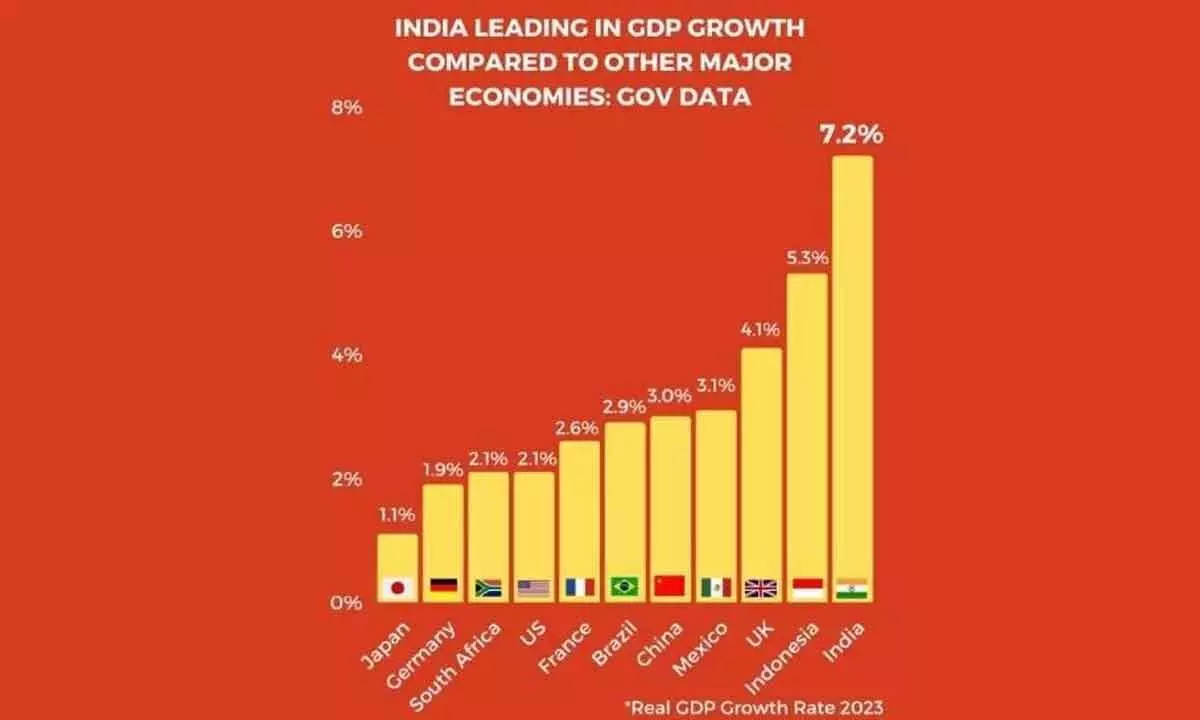The $4 trn saga that defines India’s economic roadmap
IMF data foresees India’s GDP at $4.2 trillion in the next fiscal year
image for illustrative purpose

On 19 November, an unverified screenshot went viral. It was trending on X, formerly known as Twitter. It was a grab of the live tracking feed of GDP for all countries and allegedly belonged to the International Monetary Fund (IMF). It showed India’s economy surpassing the $4 trillion mark.
World’s biggest economies are: United States: $26.9 trillion; China: $17.7 trillion; Germany: $4.4 trillion; Japan: $4.2 trillion and India: $3.75 trillion.
In June the GDP touched the $3.75 trillion mark, according to the Union finance ministry data. This is up from the $2 trillion mark in 2014. So the economy has been growing steadily for quite some time. Even during the pandemic and the global economic gloom that followed it, India remained resilient.
Well if it is not $4 trillion yet, how far is India from its goal? Not so far.
According to IMF data, India’s GDP will reach $4.2 trillion in the next fiscal year. India is now pegged to become a $7 trillion economy by 2030 according to various estimates.
At this rate of growth, it will still take India three years to surpass Japan to become the fourth largest economy.
Which brings us to the question, when will India become a $5 trillion economy? Nominal growth will have to average 9.1 per cent to reach this goal by 2027. If that happens, India will surpass Germany as well. Having said that, one should not forget that there are many challenges up ahead.
Former RBI Governor D. Subbarao has listed eight main challenges: Increasing investment; improving productivity; improving health and education; creating jobs; raising agriculture productivity; maintaining macroeconomic stability; managing global mega-trends and improving governance.
In the global order, the Indian stock market is ranked fifth in terms of market value, behind the US ($47 trillion), China ($9.7 trillion), Japan ($5.9 trillion) and Hong Kong ($4.8 trillion).
According to the latest forecast by Gartner Inc., worldwide information technology spending is set to grow by 2.4 per cent, totaling $4.5 trillion in 2023. This is down from Gartner’s previous quarter’s forecast of 5.1 per cent growth.
Spending in software and IT services are projected to increase by 9.3 per cent and 5.5 per cent, respectively, in 2023. End-user hardware spending, in contrast, is forecast to plummet as both consumers and enterprises defer device upgrades.
While inflation continues to weaken consumer purchasing power, and contribute to layoffs in business to consumer (B2C) enterprises, IT spending is expected to keep up its momentum, in spite of an impending recession.
Furthermore, as software spend goes up, the IT services market is growing and companies are looking to bring in outside IT staff for implementation and support. Spending on consulting is expected to reach $264.9 billion in 2023, a 6.7 per cent increase from 2022.
According to Lovestock, “CIOs are losing the competition for talent. IT services spending is growing more quickly than internal services in every industry. Skilled IT workers are migrating away from the enterprise CIO towards technology and service providers (TSPs) who can keep up with increased wage requirements, development opportunities and career prospects.”
Generative AI is estimated to yield an annual economic value of $2.6 to $4.4 trillion globally, with the highest impact expected across high tech, banking, and retail industry. Across the four application themes - concision/virtual experts, coding, customer engagement and content generation - approximately 75 per cent of the value is expected to be concentrated in four functions – sales and marketing, software engineering, customer operations, and product and R&D.
India is currently striving for a $5 trillion economy status. Agriculture contributes $400 billion to the Indian economy, which is second after China. To achieve this mammoth national target, all sectors of economy viz., agriculture, industry and service have to outperform outstanding.
To achieve this target, our total export should be of the order of $one trillion annually, while the share of agriculture and the allied sector should be 10 %.
To achieve $100 million agri-export, smart agriculture is pivotal to sustain our products at international level. Agritech startup can play a vital role in this endeavour; however, the bottleneck should be removed within the least possible time.
If we succeed in this endeavour, this will not only lead to enhance per capita income from the current $1800 to $3600 but also systematically double income from farming.

